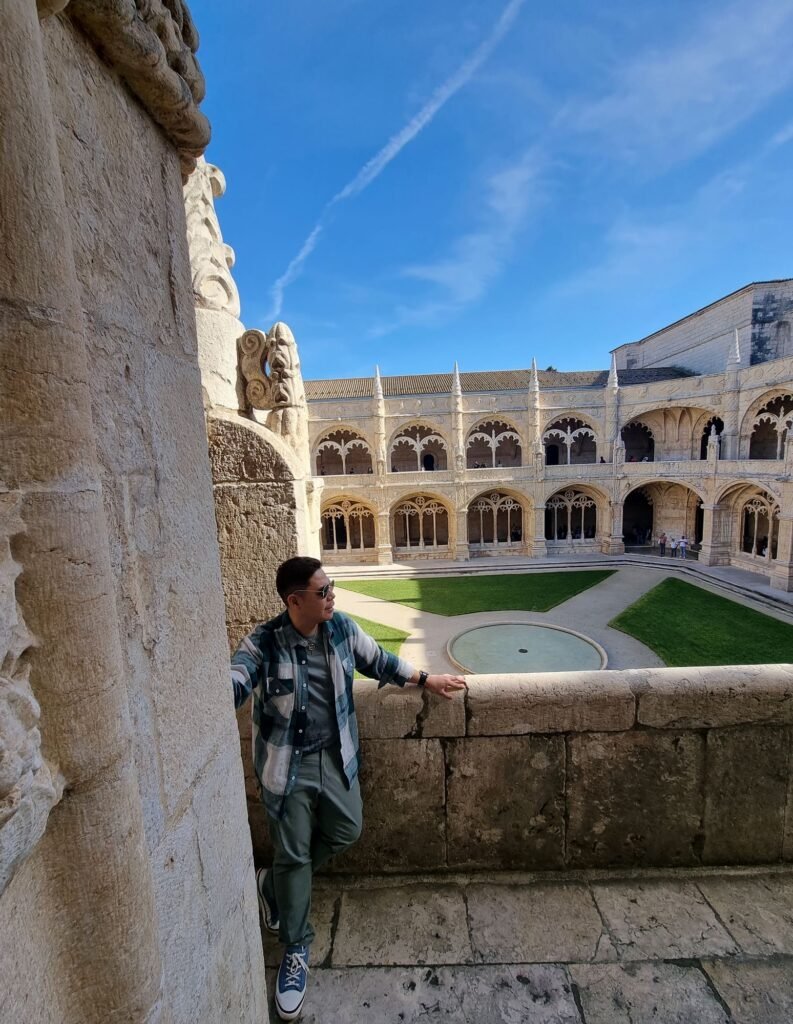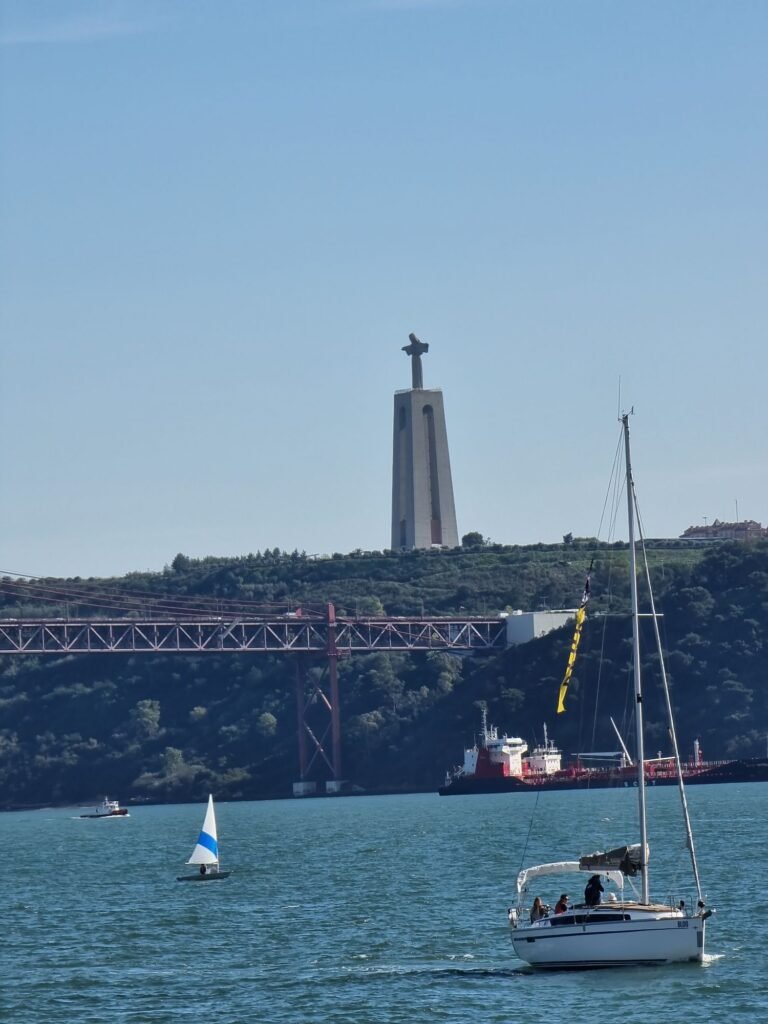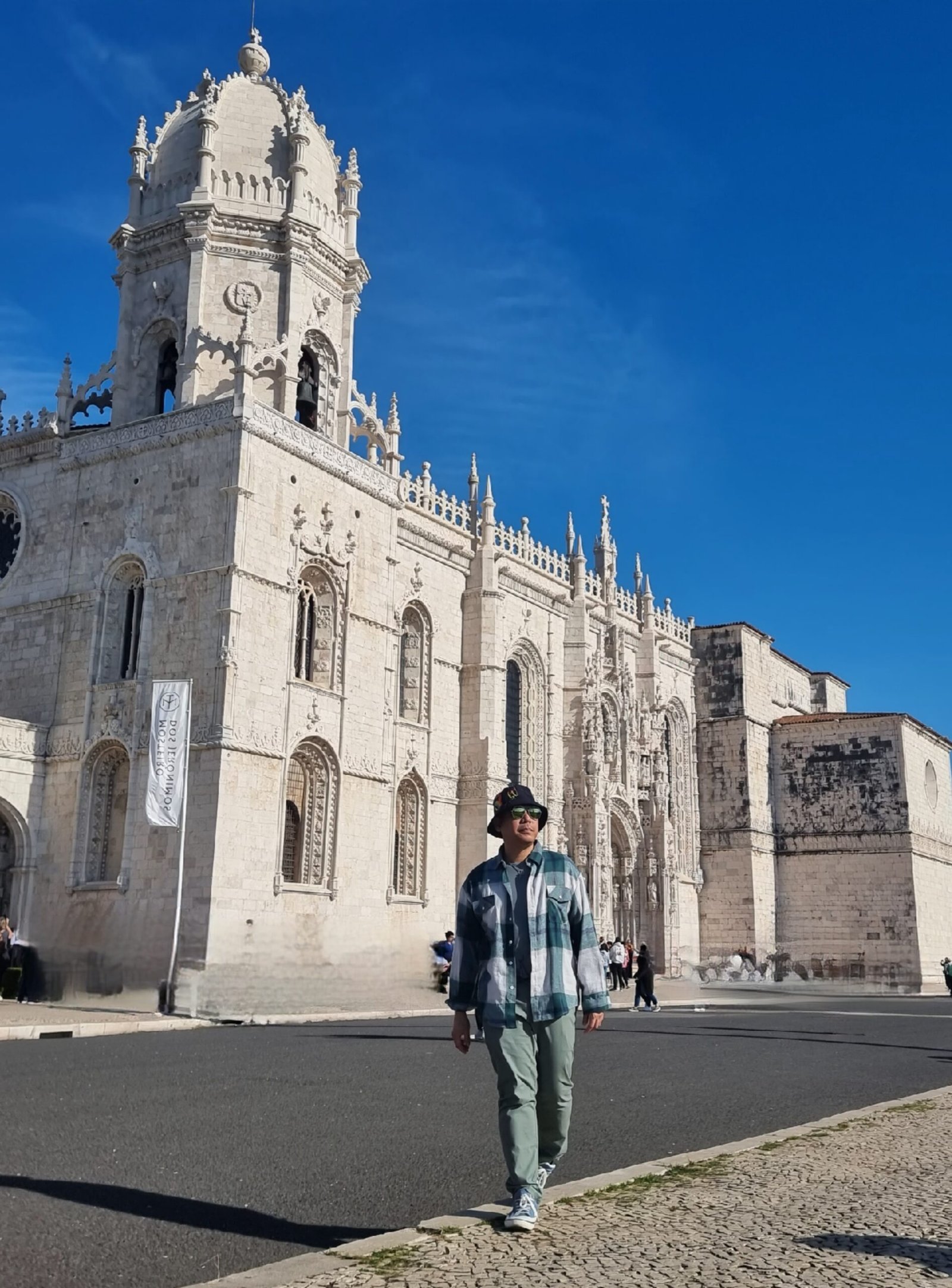A Day Trip in Lisbon: Exploring the Heart of Portugal
Join us on a whirlwind adventure as we embark on a day trip to Lisbon, the vibrant and historic capital of Portugal. From the moment we touch down at Portela Airport to the time we bid farewell to this beautiful city, we’ll take you on a journey through centuries of history, culture, and beauty.
Our day begins bright and early at Paris Charles de Gaulle Airport, where we board an early morning flight bound for Portugal. As we arrive in Lisboa, we’re greeted by the warm embrace of Portuguese sunshine and the promise of adventure in this captivating city.
With our luggage safely stored at the airport, we set off to explore Lisbon’s most iconic landmarks and hidden gems. From the grandeur of the Jerónimos Monastery to the breathtaking views from Castelo de São Jorge, every moment is a discovery waiting to be made.
Join us as we wander through the historic streets of Lisbon’s city center, hop aboard the iconic old tram, and indulge in delicious Portuguese cuisine at a charming local restaurant. From the bustling Praça do Comércio to the tranquil gardens of the Belém district, we’ll show you the best that Lisbon has to offer in just one unforgettable day.
So, pack your bags and join us as we explore the heart of Portugal on a day trip to Lisbon that you’ll never forget!
Table of Contents
4:00 AM – Check-in at Paris Charles de Gaulle Airport:

The airport is surprisingly busy for this early hour, a testament to the popularity of Lisbon as a travel destination. After a smooth check-in process, we receive our boarding passes and head towards security, our anticipation growing with each step.
As we make our way to the departure gate, the aroma of freshly brewed coffee fills the air, and we can’t resist grabbing a cup to wake ourselves up before the flight. With our caffeine fix in hand, we finally board our early morning flight to Lisbon, ready to make the most of every moment in this beautiful city.
9:00 AM – Arriving in Lisbon:

The sun is just beginning to rise as our plane touches down at Portela Airport. Stepping off the aircraft, we’re greeted by the warm embrace of Portuguese sunshine, a welcome change from the early morning chill we left behind in Paris.
After breezing through passport control, our first task is to find a secure place to store our luggage for the day. Opting for convenience, we make a beeline for the airport’s locker service. With our bags safely stowed away, we feel unburdened and ready to explore the city at our own pace.
As we exit the airport, we’re greeted by the sights and sounds of Lisbon, a city bustling with energy and charm. The promise of adventure hangs in the air, and we can’t wait to dive in and discover all that this historic city has to offer. With a map in hand and a spring in our step, our Lisbon adventure begins.
10:00 AM – Mosteiro dos Jerónimos (Jerónimos Monastery):

Our first destination is the magnificent Jerónimos Monastery, a masterpiece of Portuguese architecture and a UNESCO World Heritage Site. As we approach, we’re immediately struck by the grandeur of the building, its intricate façade adorned with delicate carvings and intricate details.

Built in the Portuguese Late Gothic Manueline style, the monastery is a true testament to the country’s rich cultural and architectural heritage. We pause to admire the façade, taking in the elaborate stone carvings depicting scenes from Portugal’s maritime history, including exotic animals, nautical motifs, and symbols of exploration.
Entering the monastery, we find ourselves in the spacious cloister, a tranquil oasis of calm in the heart of the bustling city. The delicate stone arches and ornate columns create a sense of serenity, and we take a moment to appreciate the beauty and craftsmanship of this historic site.

Wandering through the monastery, we visit the Church of Santa Maria, with its soaring vaulted ceilings and beautiful stained glass windows. We’re struck by the sense of reverence and awe that fills the space, a testament to the monastery’s importance as a place of worship and pilgrimage.
As we explore further, we come across the tomb of Vasco da Gama, the renowned Portuguese explorer who played a key role in the Age of Discovery. It’s a humbling reminder of the monastery’s rich history and its significance in shaping Portugal’s cultural and maritime identity.

Leaving the monastery, we’re filled with a sense of wonder and admiration for this architectural masterpiece. The Jerónimos Monastery is not just a building; it’s a symbol of Portugal’s golden age of exploration and discovery, and we feel privileged to have experienced its grandeur firsthand.
What to See in Mosteiro dos Jerónimos (Jerónimos Monastery):

Cloister:
Begin your visit by exploring the monastery’s stunning cloister, an architectural masterpiece adorned with intricate Manueline carvings. Take a moment to admire the delicate stone arches and ornate columns, and soak in the peaceful atmosphere of this tranquil oasis.
Church of Santa Maria:

Step inside the Church of Santa Maria, located within the monastery complex, and marvel at its magnificent interior. Admire the soaring vaulted ceilings, beautiful stained glass windows, and ornate altars, and take a moment to appreciate the church’s rich history and religious significance.
Tomb of Vasco da Gama:
Pay your respects at the tomb of Vasco da Gama, the renowned Portuguese explorer who played a key role in the Age of Discovery. Located within the Church of Santa Maria, the tomb is a stunning example of Renaissance sculpture and a must-see for history enthusiasts.
Monastery Museum:
Explore the monastery’s museum, which houses a fascinating collection of artifacts related to Portugal’s maritime history and exploration. Learn about the country’s golden age of discovery and the brave explorers who helped shape the course of world history.
Manueline Architecture:
Take time to appreciate the monastery’s exquisite Manueline architecture, characterized by its intricate stone carvings, maritime motifs, and elaborate decoration. Admire the façade of the monastery, with its delicate lacework of stone, and marvel at the skill and craftsmanship of the artisans who built it.
Refectory:

Visit the monastery’s refectory, where the monks would gather to eat their meals in silence. Admire the simple yet elegant architecture of the space, and imagine what life must have been like for the monks who once called this place home.
Gift Shop:
Before you leave, don’t forget to stop by the monastery’s gift shop, where you’ll find a range of souvenirs, books, and gifts inspired by Portuguese culture and history. Pick up a memento of your visit to this iconic landmark, and support the preservation of Portugal’s rich cultural heritage.
Suggested Activities at Mosteiro dos Jerónimos (Jerónimos Monastery):
Audio Guide Tour:
Opt for an audio guide tour to enhance your visit to the monastery. Learn about the history, architecture, and significance of each area as you explore at your own pace.
Photography:
Capture the stunning architecture and intricate details of the monastery with your camera or smartphone. From the elaborate façade to the peaceful cloister, there are endless photo opportunities waiting to be discovered.
Attend a Guided Tour:
Join a guided tour led by knowledgeable local guides who can provide in-depth insights into the monastery’s history and significance. Learn fascinating stories and anecdotes about the monks who once lived here and the role the monastery played in shaping Portugal’s history.
Visit the Maritime Museum:
Extend your visit by exploring the nearby Maritime Museum, located within the monastery complex. Discover exhibits showcasing Portugal’s rich maritime heritage, including model ships, navigational instruments, and artifacts from the Age of Discovery.
Enjoy a Coffee Break:
Take a break from your exploration and enjoy a leisurely coffee or snack at one of the nearby cafes. Relax and soak in the atmosphere as you reflect on the beauty and history of this iconic landmark.
Participate in a Workshop:
Castelo de São Jorge:
Check the monastery’s schedule for any special events or workshops taking place during your visit. From art classes to traditional crafts demonstrations, there may be opportunities to engage with Portuguese culture in a hands-on way.
Take a Guided Walking Tour:
Explore the surrounding neighborhood of Belém on a guided walking tour. Visit other nearby attractions such as the Belém Tower and the Monument to the Discoveries, and learn more about the history and culture of this historic district.
Relax in the Gardens:
After your visit to the monastery, take a leisurely stroll through the nearby gardens and enjoy the peaceful surroundings. Admire the beautiful landscaping and take in views of the Tagus River before continuing your exploration of Lisbon.
We take our time wandering through the historic center, taking in the sights and sounds of this lively neighborhood. From the grandeur of the Praça do Comércio to the narrow alleyways of the Alfama district, every corner of the city has its own unique charm and character.
11:00 AM – Belém Tower and Igreja de São Roque:
With hearts full of gratitude and appreciation for all that we’ve seen and experienced, we bid farewell to Lisbon, knowing that we’ll carry a piece of this beautiful city with us wherever we go.

After exploring the Jerónimos Monastery, we continue our journey through Lisbon’s rich history by making our way to Belém Tower, another UNESCO World Heritage Site and an iconic symbol of Portugal’s Age of Discovery.
Belém Tower:
As we approach Belém Tower, we’re immediately struck by its imposing presence on the banks of the Tagus River. Built in the early 16th century, the tower served as a fortress to defend the city from maritime attacks and played a crucial role in Portugal’s golden age of exploration.
We take a moment to admire the tower’s intricate Manueline architecture, with its delicate carvings and ornate detailing. Climbing to the top, we’re rewarded with panoramic views of the river and the surrounding area, offering a glimpse into Lisbon’s maritime past.
History of Belém Tower:
Built in the early 16th century, Belém Tower was constructed during the height of Portugal’s maritime expansion. Commissioned by King Manuel I, the tower served as both a ceremonial gateway to the city of Lisbon and as a fortress to defend the harbor from maritime attacks.
Architectural Significance:
As we approach Belém Tower, we’re immediately struck by its imposing presence on the banks of the Tagus River. The tower’s architectural style is a prime example of Manueline architecture, a uniquely Portuguese style characterized by intricate stone carvings and maritime motifs.
Purpose and Design:
Belém Tower was strategically positioned to defend the harbor and control access to the city. Its design includes features such as battlements, turrets, and a drawbridge, all designed to repel potential invaders. At the same time, the tower’s ornate façade and decorative elements served as a symbol of Portugal’s wealth and power during the Age of Discovery.
Exploring Belém Tower:
As we approach the tower, we’re struck by its intricate detailing and imposing presence. Climbing to the top, we’re rewarded with panoramic views of the river and the surrounding area, offering a glimpse into Lisbon’s maritime past.
Inside the tower, we explore the various chambers and passageways, imagining what life must have been like for the soldiers who once guarded this fortress. From the battlements, we can see the nearby Monument to the Discoveries, another iconic symbol of Portugal’s seafaring heritage.
Legacy and UNESCO World Heritage Status:
Today, Belém Tower stands as a testament to Portugal’s rich maritime history and is recognized as a UNESCO World Heritage Site. It is a must-visit destination for anyone interested in exploring Lisbon’s historic past and experiencing firsthand the architectural wonders of the Age of Discovery.
Leaving Belém Tower, we’re filled with a sense of awe and appreciation for the history and significance of this iconic landmark. As we continue our journey through Lisbon, we carry with us the memories of this magnificent fortress and the stories it has to tell about Portugal’s golden age of exploration.
Igreja de São Roque:
From Belém Tower, we make our way to the nearby Igreja de São Roque, a stunning example of Baroque architecture and home to some of the most beautiful azulejos (traditional Portuguese tiles) in Lisbon.

Stepping inside the church, we’re immediately struck by the opulence and grandeur of its interior. The richly decorated ceiling, intricate gilded altars, and stunning azulejos transport us to another time, where wealth and power were on full display.
We take our time exploring the church, marveling at the beauty of its architecture and the skill of the craftsmen who created it. From the Chapel of St. John the Baptist, with its breathtaking marble sculptures, to the Chapel of St. Anthony, with its stunning azulejos depicting scenes from the life of the saint, every corner of the church is a feast for the eyes.
As we leave Igreja de São Roque, we’re filled with a sense of awe and wonder at the beauty and history of Lisbon’s churches. From the grandeur of Belém Tower to the splendor of Igreja de São Roque, our day trip through Lisbon has been a journey through the centuries, and we can’t wait to see what else this historic city has in store.
History of Igreja de São Roque:
Igreja de São Roque, or Church of Saint Roch, is one of Lisbon’s oldest churches and holds a special place in the city’s religious and cultural heritage. Originally built in the 16th century by the Jesuits, the church was one of the first Jesuit churches in Portugal and played a significant role in the spread of the Jesuit order throughout the country.
Significance of Igreja de São Roque:
The church is renowned for its magnificent Baroque interior, which is considered one of the finest examples of Baroque architecture in Portugal. From the moment we step inside, we’re immediately struck by the opulence and grandeur of its interior.
Important Events:
One of the most important events in the history of Igreja de São Roque was the earthquake of 1755, which devastated much of Lisbon but left the church miraculously intact. As a result, the church’s interior remains largely unchanged since the 18th century, providing visitors with a rare glimpse into Lisbon’s Baroque past.
Exploring Igreja de São Roque:
Stepping inside the church, we’re greeted by a riot of color and ornamentation. The richly decorated ceiling, intricate gilded altars, and stunning azulejos transport us to another time, where wealth and power were on full display.
We take our time exploring the church, marveling at the beauty of its architecture and the skill of the craftsmen who created it. From the Chapel of St. John the Baptist, with its breathtaking marble sculptures, to the Chapel of St. Anthony, with its stunning azulejos depicting scenes from the life of the saint, every corner of the church is a feast for the eyes.
Legacy and Significance:
Today, Igreja de São Roque stands as a testament to Lisbon’s rich religious and cultural heritage and is considered one of the city’s most important architectural landmarks. Its stunning interior and historical significance make it a must-visit destination for anyone exploring Lisbon’s historic center.
Leaving Igreja de São Roque, we’re filled with a sense of awe and wonder at the beauty and history of Lisbon’s churches. From the grandeur of Belém Tower to the splendor of Igreja de São Roque, our day trip through Lisbon has been a journey through the centuries, and we can’t wait to see what else this historic city has in store.
1:00 PM – Lunch at A Provinciana:
After a morning of exploration, our stomachs are rumbling, and we’re ready to refuel with some delicious Portuguese cuisine. We’ve heard great things about A Provinciana, a charming restaurant known for its traditional dishes and warm hospitality.

History of A Provinciana:
A Provinciana has been a beloved fixture in Lisbon’s culinary scene for over 50 years. Founded by the Silva family in the heart of Lisbon’s historic center, the restaurant has earned a reputation for serving some of the best traditional Portuguese cuisine in the city.
Special Dish:


As we take our seats, we’re greeted by the tantalizing aroma of grilled seafood and spices. We decide to start with a selection of petiscos (Portuguese tapas), including grilled sardines, octopus salad, and codfish cakes. For our main course, we opt for one of A Provinciana’s specialties: Cataplana de Marisco, a flavorful seafood stew made with clams, shrimp, and fish, cooked in a rich tomato and garlic sauce.
Dessert:

No meal in Portugal would be complete without indulging in a sweet treat, and A Provinciana does not disappoint. We end our meal with a slice of Pastel de Nata, a traditional Portuguese egg custard tart dusted with cinnamon and powdered sugar. The tart is warm and creamy, with a perfectly flaky crust, and it’s the perfect way to satisfy our sweet tooth.
Significance of the Canteen:
As we enjoy our meal, we can’t help but notice the cozy and welcoming atmosphere of the restaurant. The walls are adorned with vintage photographs and memorabilia, and the air is filled with the sounds of laughter and conversation. A Provinciana is more than just a restaurant; it’s a gathering place for locals and visitors alike, where people come together to enjoy delicious food, good company, and the warm hospitality of the Silva family.
Leaving A Provinciana, we’re filled with a sense of contentment and satisfaction. Our meal was not just a culinary experience; it was a celebration of Portuguese culture and hospitality, and we feel grateful to have been a part of it. With our hunger satisfied and our spirits lifted, we’re ready to continue our exploration of Lisbon’s historic streets.
2:30 PM – Exploring the Historic Center:
With our hunger satisfied and our spirits lifted, we set off to explore Lisbon’s historic center. Stepping out of A Provinciana, we find ourselves immersed in the bustling streets of this vibrant city. Cobblestone lanes wind their way through colorful buildings adorned with wrought-iron balconies and terracotta roofs, and the air is filled with the sound of laughter and conversation.
Wandering Through the Streets:

Exploring with the Old Tram:

As we make our way through the streets, we decide to embrace a quintessential Lisbon experience and hop aboard one of the city’s iconic old trams. Clinging to the outside of the tram, we rattle and clatter our way through the narrow streets, passing by historic landmarks and charming neighborhoods.
Highlights of our Exploration:
Praça do Comércio:
We begin our exploration at Praça do Comércio, Lisbon’s grandest square. Bordered by elegant arcades and colorful buildings, the square offers breathtaking views of the Tagus River and the iconic Ponte 25 de Abril bridge.
Alfama District:
Next, we make our way to the historic Alfama district, the oldest neighborhood in Lisbon. Here, narrow cobblestone streets wind their way past ancient churches, hidden courtyards, and traditional fado bars, offering a glimpse into the city’s rich history and culture.
Miradouros:
We also make sure to visit one of Lisbon’s famous miradouros, or viewpoints, where we’re treated to panoramic views of the city and the river below. From here, we can see the red rooftops of Lisbon stretching out to the horizon, a breathtaking sight that captures the essence of this beautiful city.
Embracing Lisbon’s Charm:
As we explore Lisbon’s historic center, we can’t help but be charmed by the city’s beauty and vibrancy. From the historic landmarks to the lively streets, every moment in Lisbon feels like a new adventure, and we’re grateful to be experiencing it all firsthand.
Leaving the historic center behind, we’re filled with a sense of wonder and excitement for the rest of our Lisbon adventure. With its rich history, stunning architecture, and warm hospitality, Lisbon has captured our hearts, and we can’t wait to see what else this beautiful city has in store.
3:30 PM – Elevador de Santa Justa and Praça do Comércio:

After a delightful exploration of Lisbon’s historic center, our next destination is the iconic Elevador de Santa Justa, a wrought-iron elevator that offers stunning panoramic views of the city.
Elevador de Santa Justa:
As we make our way to the Elevador de Santa Justa, we’re struck by the beauty of its intricate wrought-iron structure. Designed by Gustave Eiffel’s apprentice, Raoul Mesnier du Ponsard, the elevator is a masterpiece of 19th-century engineering and a beloved symbol of Lisbon.
We ascend to the top of the elevator, where we’re treated to breathtaking views of the city stretching out before us. From here, we can see the red rooftops of Lisbon, the sparkling waters of the Tagus River, and the majestic São Jorge Castle perched high on a hill.
Praça do Comércio:

Leaving the Elevador de Santa Justa behind, we make our way to Praça do Comércio, Lisbon’s grandest square and one of the city’s most iconic landmarks.
Bordered by elegant arcades and colorful buildings, the square is a testament to Lisbon’s rich maritime history and imperial past. At the center of the square stands a magnificent statue of King José I, surrounded by marble columns and majestic arches.
We take our time exploring the square, soaking in the sights and sounds of this bustling hub of activity. From street performers and vendors selling souvenirs to locals and tourists alike, Praça do Comércio is alive with energy and excitement.
As we gaze out over the Tagus River, we’re filled with a sense of awe and wonder at the beauty of Lisbon and the rich history that surrounds us. From the Elevador de Santa Justa to Praça do Comércio, our day trip through Lisbon has been a journey through the city’s past and present, and we can’t wait to see what else this vibrant city has in store.
5:00 PM – Sé de Lisboa (Lisbon Cathedral) and Castelo de São Jorge:

Continuing our exploration of Lisbon’s rich history, our next stop is the magnificent Lisbon Cathedral, also known as Sé de Lisboa. Dating back to the 12th century, this beautiful Romanesque church is one of the oldest and most important landmarks in the city.
Sé de Lisboa (Lisbon Cathedral):
As we approach Sé de Lisboa, we’re struck by the grandeur and beauty of its façade. The cathedral’s Romanesque architecture is an impressive sight, with its sturdy stone walls and elegant rose window.
Stepping inside, we’re greeted by a sense of peace and tranquility. The interior of the cathedral is adorned with beautiful stained glass windows, intricate carvings, and majestic vaulted ceilings. We take a moment to admire the beauty of the nave and the altar, soaking in the atmosphere of this sacred space.
From Sé de Lisboa, we make our way to Castelo de São Jorge, a Moorish castle perched high on a hill overlooking the city. As we climb the winding streets that lead to the castle, we’re treated to panoramic views of Lisbon stretching out before us.
Originally built in the 11th century by the Moors, Castelo de São Jorge has played a key role in Lisbon’s history, serving as a royal residence, a military fortress, and a prison over the centuries. Today, the castle is a popular tourist attraction, offering visitors the chance to explore its historic walls, towers, and ramparts, and enjoy stunning views of the city below.
As we wander through the castle grounds, we imagine what life must have been like for the kings and queens who once called this place home. From the medieval battlements to the lush gardens and hidden courtyards, Castelo de São Jorge is a fascinating glimpse into Lisbon’s past.
Leaving the castle behind, we’re filled with a sense of wonder and awe at the history and beauty of Lisbon. From the ancient walls of Sé de Lisboa to the panoramic views of Castelo de São Jorge, our day trip through Lisbon has been a journey through the centuries, and we’re grateful to have experienced it all.
Reflection and Contemplation:
As we wander through the mausoleum, we take a moment to reflect on the history and significance of this remarkable monument. The Panteão Nacional is more than just a final resting place; it’s a tribute to the men and women who have shaped Portugal’s identity and left an indelible mark on its history.
Heading Back to the Airport:
As the sun begins to set over Lisbon, we reluctantly tear ourselves away from the Panteão Nacional and make our way back to the airport. Our day trip may be coming to an end, but the memories we’ve made will last a lifetime.
7:30 PM – Return to the Airport:
As the sun begins to set over Lisbon, signaling the end of our day trip in this beautiful city, we make our way back to Lisbon Portela Airport. The streets are alive with the sounds of laughter and conversation as locals and tourists alike enjoy the vibrant nightlife of the city.
Retrieving Our Luggage:
Arriving at the airport, we make a beeline for the luggage locker where we stored our belongings earlier in the day. With a sense of anticipation, we retrieve our bags, grateful for the convenience and peace of mind that the locker provided.
Check-in for Our Flight:
With our luggage in tow, we make our way to the check-in counter to prepare for our evening flight back to Paris. The airport is bustling with activity as travelers come and go, and we take a moment to savor the last remnants of our Lisbon adventure.
Farewell to Lisbon:
As we board our flight and settle into our seats, we can’t help but feel a twinge of sadness at saying goodbye to this beautiful city. From the historic landmarks to the charming neighborhoods, Lisbon has captured our hearts in just one day, and we know that we’ll carry the memories of our visit with us for a lifetime.
Until We Meet Again:
As the plane takes off and we bid farewell to Lisbon, we’re filled with gratitude for the incredible day we’ve had and the experiences we’ve shared. From the grandeur of Belém Tower to the tranquility of Sé de Lisboa, our day trip through Lisbon has been a journey through history, culture, and beauty.
As we soar through the night sky, we carry with us the warmth and hospitality of Lisbon, knowing that we’ll return again someday to create even more memories in this remarkable city.
Obrigado, Lisbon, for an unforgettable day!
Conclusion:
As our day trip to Lisbon comes to an end, we find ourselves filled with a sense of wonder and gratitude for the experiences we’ve shared and the memories we’ve made in this beautiful city. From the grandeur of Belém Tower to the tranquility of Sé de Lisboa, our day has been a journey through centuries of history, culture, and beauty.
We’ve marveled at the intricate architecture of the Jerónimos Monastery, wandered through the historic streets of Lisbon’s city center, and enjoyed delicious Portuguese cuisine at a charming local restaurant. We’ve explored hidden gems and iconic landmarks, taken in breathtaking views from Castelo de São Jorge, and soaked in the vibrant atmosphere of Lisbon’s bustling neighborhoods.
But more than the sights and sounds, it’s the warmth and hospitality of the people of Lisbon that have left the biggest impression on us. From the friendly locals we met along the way to the welcoming smiles of the restaurant staff, Lisbon has made us feel right at home from the moment we arrived.
As we board our flight back to Paris, we carry with us the memories of our day trip to Lisbon, knowing that we’ve experienced something truly special in this captivating city. Until next time, Lisbon. Obrigado for an unforgettable day!


